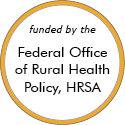Rural Project Examples: Health disparities
Effective Examples
Kentucky Homeplace
Updated/reviewed October 2025
- Need: Rural Appalachian Kentucky residents have deficits in health resources and health status, including high levels of cancer, heart disease, hypertension, asthma, and diabetes.
- Intervention: Kentucky Homeplace was created as a community health worker initiative to provide health coaching, increased access to health screenings, and other services.
- Results: From July 2001 to June 2025, over 202,000 rural residents were served. Preventive health strategies, screenings, educational services, and referrals are all offered at no charge to clients.
The Health-able Communities Program

Updated/reviewed August 2024
- Need: Expand healthcare access for the more remote residents of 3 frontier counties in north central Idaho.
- Intervention: With early federal grant-funding, a consortium of healthcare providers and community agencies used a hybrid Community Health Worker model to augment traditional healthcare delivery services in order to offer a comprehensive set of health-related interventions to frontier area residents.
- Results: With additional private grant funding, success continued to build into the current model of an established and separate CHW division within the health system's population health department.
Promising Examples
Health Extension Regional Offices (HEROs)
Updated/reviewed May 2024
- Need: People in rural New Mexico often found it difficult to find and utilize needed resources from the University of New Mexico Health Sciences Center (UNMHSC).
- Intervention: UNMHSC created Health Extension Regional Offices (HEROs), in which HERO agents live in the communities they serve, help identify health and social needs, and link them with UNMHSC and other university resources.
- Results: In their regions, HERO agents' activities have been wide-ranging, including recruiting physicians, mobilizing research funds to address local priorities, working on economic development, training laypeople in Mental Health First Aid, and helping local institutions access UNMHSC resources.
Other Project Examples
Healthy Monadnock Alliance
Updated/reviewed November 2025
- Need: Improved health outcomes for Monadnock Region, a rural area of New Hampshire.
- Intervention: A wide-scale effort across multiple sectors is aiming to improve health outcomes throughout the region.
- Results: Community health trends have been tracked over time, and progress on goals such as increasing the number of residents with healthcare coverage, opportunities for physical activity, access to healthy foods, and smoking cessation has been made.
Rural Libraries and Health Cooperative Agreement
Updated/reviewed July 2024
- Need: To increase access to healthcare and social services in rural South Carolina via library systems.
- Intervention: Pilot sites are hiring social workers and community health workers to provide consultations, case management, and referrals.
- Results: One library screens an average of 215 residents a month, and another library's programming reached over 800 female patrons.
HealthStreet Cognitive Screening Project
Updated/reviewed November 2023
- Need: Because of the benefits associated with early identification of conditions causing memory problems, Florida's rural populations will benefit from access to screening for possible Alzheimer's Disease and other types of dementia.
- Intervention: A state university uses a state health department grant to develop a cognitive impairment screening program implemented by rural Community Health Workers. An additional grant provides rural medical practitioners with a free online continuing education module covering cognitive impairment and dementia.
- Results: To date, over 400 individuals have completed health screenings and over 900 referrals have been made to community social and medical services. At grant cycle completion, formal analysis of cognitive screening and referral to medical services will be shared.
Boone County Health Center Pulmonary Rehabilitation Program
Updated/reviewed June 2022
- Need: Evidenced-based intervention to improve function and quality of life for patients with chronic obstructive pulmonary disease and other chronic lower respiratory conditions.
- Intervention: Pulmonary rehabilitation program implementation in 1989.
- Results: Compared to a national average of only about 3% of referred Medicare beneficiaries actually enrolling in pulmonary rehabilitation, 60% of the program's referred patients enroll. Averaging around 15 patients/year completing the program, a large combined cardiac and pulmonary rehabilitation maintenance population averages 8,000 visits/year.
Avita Health System Comprehensive Cardiology Program
Added April 2021
- Need: Population health approach to decreasing area deaths from cardiovascular disease.
- Intervention: A health system-level investment in level II cardiac catheterization services and the required specialized cardiology workforce.
- Results: Since August 2018, the Avita Health System in north central Ohio has provided local cardiovascular services that have decreased hospital transfers, increased care coordination, and provided education and prevention activities that, with time, will impact population health cardiovascular outcomes.
Garrett County Regional Cancer Patient Navigator Program

Updated/reviewed March 2020
- Need: Comprehensive cancer services for residents of an 8-county, 3-state area in Appalachia.
- Intervention: Using a Cancer Patient Navigation Tool Kit, a Maryland acute care facility led a multidisciplinary collaboration that provided the area's patients with expanded cancer treatment services.
- Results: In addition to several new cancer-related programs, expanded services are now available for cancer patients, families, and cancer survivors.
For examples from other sources, see:
